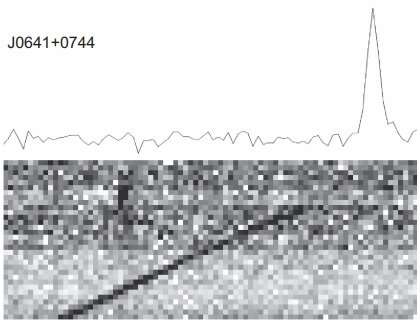Five new rotating radio transients discovered

Russian astronomers report the detection of five new rotating radio transients (RRATs) using the Big Scanning Antenna (BSA) of the Pushchino Radio Astronomy Observatory (PRAO). The discovery was detailed in a paper published July 22 on the arXiv pre-print repository.
RRATs are a subclass of pulsars characterized by sporadic emission. First objects of this type were identified in 2006 as sporadically appearing dispersed pulses, with frequencies varying from several minutes to several hours. However, the nature of these transients is still unclear. In general, it is assumed that they are ordinary pulsars that experience strong pulses.
So far, only slightly more than 100 RRATs have been found, therefore astronomers are interested in detecting more transients of this type in order to characterize them and improve our knowledge about their nature.
Recently, a team of astronomers led by PRAO’s Sergey Tyul’bashev has analyzed the data from monitoring observations with BSA at 111 MHz, conducted in September 2015. This resulted in the identification of fifty-four pulsating sources, five of which turned out to be new RRATs.
“We have used data from a program of daily monitoring to search for strong (??? ≥ 7) pulses with DM = 3–100 pc/cm3 within a region covering 15000 deg2 of the northern sky…. Fifty-four pulsating sources were detected at declinations −9?
The newfound RRATs received designations J0319+1341, J0641+0744, J1329+1344, J1336+3346 and J1556+0110. They have dispersion measures ranging from 8.5 to 52 pc/cm3. The estimated observed peak flux density of their pulses were measured to be between 4,500 and 13,000 mJy.
The astronomers noted that the dispersion measures of these sources suggest that they are Galactic objects. They added that they display sporadic repeated pulses, which confirms their RRAT nature.
The researchers try to explain why the five RRATs reported by them have not been detected by previous observations. They assume that the flare rate of these transients is low enough that the total observation time in the directions of these transients in the earlier surveys was not sufficient to enable detection of even one flare.
“If this is indeed the case, it demonstrates that the lower sensitivity of the BSA in transient searches is compensated by its ability to carry out longer monitoring,” the authors of the paper wrote.
Therefore, the researchers hope that longer monitoring should enable the detection of all RRATs whose flares are strong enough to exceed the BSA sensitivity threshold at least once in three days. They added that further BSA observations could lead to the detection of 200–300 new flare sources with strong pulses.
S.A. Tyul’bashev et al, Detection of Five New RRATs at 111 MHz. arXiv:2207.11032v1 [astro-ph.HE], arxiv.org/abs/2207.11032
© 2022 Science X Network
Citation:
Five new rotating radio transients discovered (2022, August 1)
retrieved 1 August 2022
from https://phys.org/news/2022-08-rotating-radio-transients.html
This document is subject to copyright. Apart from any fair dealing for the purpose of private study or research, no
part may be reproduced without the written permission. The content is provided for information purposes only.

